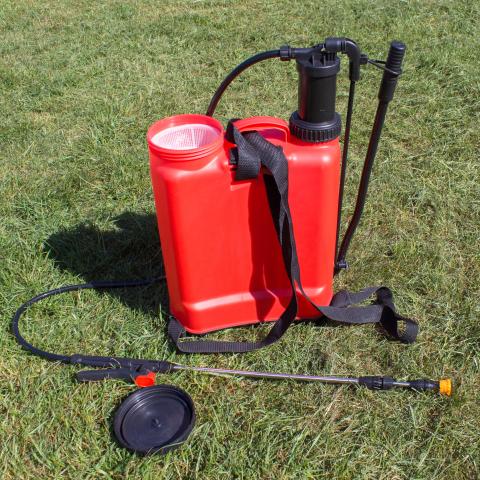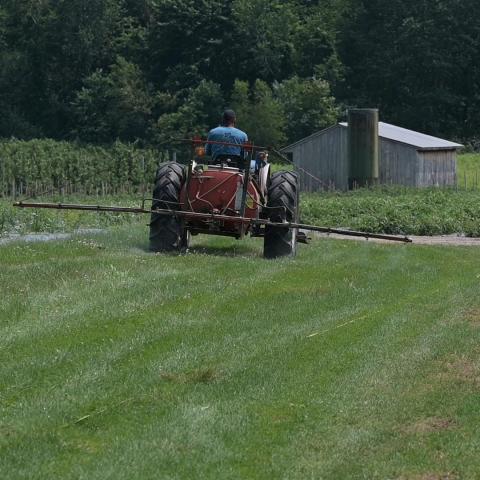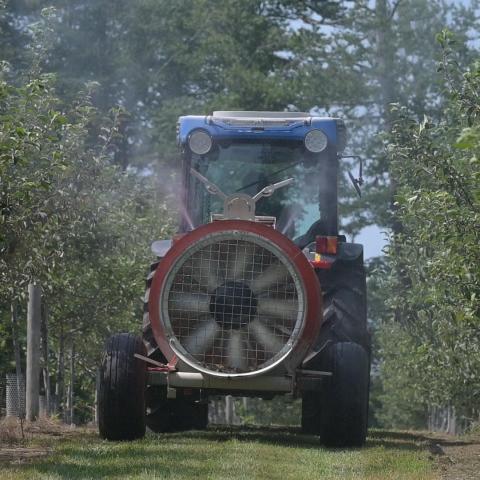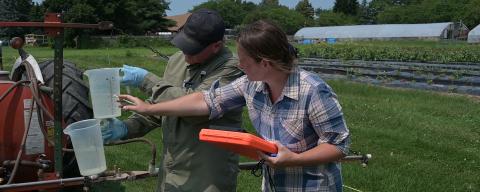Pesticide Sprayer Calibration, Use and Care
Whether you are using a backpack, boom, or air blast, or air shear sprayer, UNH Extension provides a collection of resources that will help you get the most out of your equipment.
Backpack Sprayers

Backpack sprayers are inexpensive, lightweight, easy to use, and perfectly suited to small jobs on the farm or in the landscape. Knowing how to properly use, maintain, and calibrate your backpack sprayer can have a big impact on the effectiveness, efficiency, and safety of your applications.
This collection of videos and fact sheets will help you use your backpack sprayer effectively.
Choosing and Customizing a Backpack Sprayer
These short videos provide guidance that will help you select the type of backpack sprayer that fits your needs and will help you set up that sprayer to achieve the best results.
Don’t Overlook Backpack Sprayers for Small Scale Farmers [5:38] - Farmers tend to underestimate what backpack sprayers can do for them to improve their operations, their profitability, and their efficiency. Knowing the differences between sprayer models will help you select the sprayer that will work best for you on your farm or operation.
Choosing the Right Sprayer to Enhance Spray Application and Reduce Fatigue: Comparing Two Styles of Backpack Sprayers [2:33] - The size of a sprayer’s piston pump combined with the pump’s leveraging system style has a big impact on the sprayer’s ease of use. In this video, use of a sprayer with a large internally mounted piston pump is demonstrated in comparison to a sprayer with a small externally mounted piston pump.
Reviewing Gasoline Powered Backpack Sprayers: Do They Enhance Sprayer Performance? [3:05] - While manually operated backpack sprayers are most commonly used, gas powered models are also available and may be the right fit for your needs. This video discusses how these sprayers function differently from manually operated models.
Conversion Steps for Backpack Sprayers: Improving Accuracy by Addressing the “disconnect between sprayer manufacturers and sprayer accessories suppliers” [8:47] - Modifying your backpack sprayer wand to accommodate an array of different nozzle types will give you lots of options for customizing your spray delivery. The video provides step-by-step instructions for converting your spray wand to a system that will allow you to select the best nozzle for each job.
It’s All in the Nozzle: Comparing Recent and Older Spray Nozzle Designs Addressing Various Spray Requirements [9:05] - Using a nozzle that delivers smaller spray droplets will improve the coverage you can achieve, however using a nozzle that delivers larger droplets will reduce potential for spray drift. In addition to droplet size, different nozzles provide options such as multiple spray angles, wider swath widths, and uniform droplet size. This video discusses nozzle types and the situations in which one may be preferable over another.
Backpack Sprayer Calibration
Sprayer calibration is key to efficient, accurate, and safe spraying. This collection of resources demonstrates the steps to calibrating a backpack sprayer using the “1/128th method”, discusses important factors to consider regarding safety, nozzle selection and maintenance, and provides a worksheet with video guidance that can be used to work through the calibration calculations and record keeping.
Backpack Sprayer Calibration [7:28] - This video provides an overview of how to use a backpack sprayer and how to calibrate that sprayer to deliver a known amount of product.
Backpack Sprayers Apply Liquid Products Accurately with Proper Calibration [6:20] - Calibration is a necessary step in order to apply the correct amount of product. This video discusses the three factors affecting calibration and strategies to ensure accurate calibration.
1/128th Method of Calibration
This collection of resources demonstrates the steps to calibrating a backpack sprayer using the “1/128th method”, discusses important factors to consider regarding safety, nozzle selection and maintenance, and provides a worksheet with video guidance that can be used to work through the calibration calculations and record keeping.
Backpack Sprayer Calibration: 1/128th Method Worksheet [worksheet]
Hoja de trabajo de Calibración de rociador de mochila_ Método 1_128 [hoja de cálculo]Using the Backpack Sprayer Calibration Worksheet: 1/128th Method [9:28]
"Actual Area" Sprayed Method of Calibration
In some situations, the ’Actual Area Sprayed’ method of backpack sprayer calibration will give the most accurate results. This collection of resources will help you work through the steps of calibrating your backpack sprayer, including guidance on measurements, calculations, and record keeping.
Backpack Sprayer Calibration Worksheet: Actual Area Sprayed Method [worksheet]
Hoja de trabajo de Calibración de rociador de mochila - Método de área rociada real [hoja de cálculo]- Using the Backpack Sprayer Calibration Worksheet: Actual Area Sprayed Method [6:11]
For an in-depth look at how to select, use, and maintain backpack sprayers and nozzles, two one-hour webinar-style classes are available. These classes offer one NH pesticide applicator credit per course.
Using Backpack Sprayers – Part One [course]
Using Backpack Sprayers – Part Two [course]
Mixing Pesticide Solutions
When preparing to mix pesticide solutions, you may find that the label instructions on the particular product you are planning to use are based on larger application areas and larger volumes of spray solution than what your job requires. Additionally, pesticide product label instructions differ in how mixing rates are presented. Use these worksheets to convert rates designed for large areas to equivalent rates for smaller areas. Choose the worksheet that coincides with the rate format in the label instructions for the product you are using.
Preparing Small Volumes of Spray Solution: Amount of Product per Acre - Use this calculation worksheet and video if the instructions on your product label are presented as an amount of product per acre. (i.e.: pints/acre, quarts/acre, fl oz/acre, or lbs./acre)
Preparing Small Volumes of Spray Solution: Amount of Product per 1,000 Square Feet Calculation Worksheet - Use this calculation worksheet if the instructions on your product label are presented as an amount of product per 1,000 square feet. (i.e.: pints/1000 sq ft, quarts/1000 sq ft, fl oz/1000 sq ft, or lbs/1000 sq ft)
Preparing Small Volumes of Spray Solution: Amount of Product per Gallon Calculation Worksheet - Use this calculation worksheet when the instructions on your product label are presented as an amount of product per gallon of spray solution. (i.e.: tablespoons/gal, teaspoons/gal, fl oz/gal, or oz/gallon)
Preparing Small Volumes of Spray Solution: Amount of Product per ‘X’ (Multiple) Number of Gallons - Use this calculation worksheet and video when the instructions on your product label are presented as an amount of product per some number of gallons of spray solution. (i.e.: lbs/100 gallons, quarts/10 gallons, ounces/5 gallons)
Preparing Small Volumes of Spray Solution: Percent Solution Calculation Worksheet - Use this worksheet when the instructions on your product label are presented as a percentage solution. (Example: “Apply at a rate of 1.0 - 2.0% in sufficient amounts of water to achieve complete coverage.”)
How to Accurately Measure Small Quantities of Spray Products for Backpack Sprayers [3:28] - Preparing spray products for use in a backpack sprayer requires that you have a system for accurately measuring out small quantities of chemicals. This video describes low-cost tools and strategies for measuring small amounts of liquids and dry products.
Measurements for Pesticide Application - When mixing small volumes of pesticide solutions, you may need to convert the units listed on the product label into smaller, more precise measurements. This reference sheet provides quick, accurate conversions to help ensure proper dilution and safe, effective application. Keep it on hand whenever you're preparing pesticide mixes. Always follow the label directions and precautions of the material being used.
Spray Rate Conversions - When calibrating your sprayers and preparing spray mixtures, you may find that you need to convert units between gallons per acre, gallons per 1,000 square feet, and fluid ounces per 1,000 square feet. This conversion table is a handy reference for quickly converting between these rates.
Quick Tips for Using Your Backpack Sprayer
- Selecting the Right Backpack Mist Sprayer [1:37] - The right backpack mist sprayer for the job may depend on where you will be spraying. If you will be spraying areas above shoulder height, a pump-assisted sprayer, rather than a gravity-fed sprayer will get the job done. In this video, George Hamilton discusses the differences in how these two sprayer types work.
- Control Flow Valve [1:26] - Keeping a consistent pressure in the tank ensures uniform delivery of your spray. In this video, George Hamilton shows how use of a dual compensating pressure control flow valve provides for consistent spray application regardless of how fast or slow you pump the tank.
- Putting on Your Sprayer [1:06] - A filled backpack sprayer is heavy and awkward to put on. Using care when putting on your backpack sprayer is important for avoiding injury. In this video, George Hamilton demonstrates how to put on a backpack sprayer without dangerously twisting or straining your back.
- Distance to Target [1:09] - Your owner’s manual will tell you how far you should hold the nozzle tip from your target. By marking the correct nozzle height on a table leg or other stationary object, you can easily gauge how high you will need to hold your wand in order to keep the nozzle at the right distance from the target. In this video, George Hamilton demonstrates how he uses this tip when he is preparing to spray with a backpack sprayer.
- Clearing a Clogged Nozzle [1:05] - A common problem when working with backpack sprayers is a clogged nozzle. In this video, George Hamilton demonstrates how to safely and effectively clear a clogged nozzle so that you can return to spraying at the intended rate and coverage.
- Taking Proper Notes [1:05] - With any type of sprayer, referring to your records of sprayer calibration is an important step in ensuring accuracy of your application rates. In this video, George Hamilton provides tips on keeping your calibration records easily accessible.
- Winterizing Your Sprayers - As winter approaches, it’s important to winterize your spray equipment so it will be in good condition and ready to use for the next season.
Applications in Greenhouses and Nurseries
Greenhouse Spraying Basics [10:09] - Learn the essential steps for effective and safe pesticide application in greenhouse settings. This video covers key terms, equipment prep, proper mixing and application techniques, coverage and canopy penetration tips, and post-application cleaning procedures. Ideal for greenhouse professionals looking to improve application accuracy, reduce waste, and stay compliant with safety best practices.
Greenhouse Sprayer Calibration and Spray Calculation - Use this worksheet and video to calibrate a sprayer for use in greenhouses, nurseries, or when the label rate is given in amount of pesticide per 100 gallons of spray. Application rates for pesticides labeled for use in fields are usually given in amount of pesticide per acre. By contrast, pesticides labeled for use in greenhouses and nurseries usually state application rates in amount of pesticide per 100 gallons of spray volume. This gives the greenhouse or nursery applicator greater flexibility to alter the amount of pesticide applied to a given area based on plant size and density. As such, however, determining how much spray to mix and how to calibrate a sprayer for a greenhouse or nursery application requires a different procedure than those shown above for other backpack sprayer applications.
Using Your Injector for Pesticide Applications [41:07] - Injectors can be a convenient and affordable way to provide a drench to containerized crops. Learn how to properly calculate, mix and deliver a drench using a proportional injector in this webinar recording.
Delivering a Drench Using an Injector Worksheet - Injectors are a convenient and affordable way to provide a drench to containerized crops, but this method must be calculated and calibrated properly. This worksheet will walk you through the steps.
Boom Sprayers
Boom sprayers are one of the most common types of sprayers used in agricultural production as well as in landscape, turf, and rights-of-way applications. Knowing how to properly use, maintain, and calibrate your boom sprayer can have a big impact on the effectiveness, efficiency, and safety of your applications.

This collection of videos, fact sheets, and worksheets will help you use your boom sprayer effectively.
These short videos provide guidance that will help you set up and use your boom sprayer.
Checking Distance to Target [0:51] - Your owner’s manual will tell you how far your nozzles should be from your target in order to achieve the intended application rate and coverage. In this video, George Hamilton demonstrates how to measure the distance from each nozzle on the boom to the top of the crop and compare this measured distance to the distance indicated in the owner’s manual.
Checking Nozzle Distance [1:04] - Your owner’s manual will tell you how far apart nozzles should be along the boom. In this video, George Hamilton demonstrates measuring the distance between nozzles and comparing that to the spacing indicated in the owner’s manual. If nozzles are too close or too far apart, you will have overlap or gaps in your spray coverage.
Broadcast Sprayer Uniformity [1:24] - This video shows how to test the uniformity of your broadcast sprayer by spraying it over blacktop on a dry sunny day. Watch the uniformity of the drying pattern on the ground to gauge the uniformity of your spray application.
Check your Primary Filter [1:20] - When filling your sprayer tank, be sure to check the primary filter to make sure it’s clean, as shown in this video. If you find that’s it’s dirty, be sure to check your nozzles to see if they’re clogged before spraying.
Pressure Gauge Accuracy [2:18] - When using any type of sprayer, pressure gauges will tell you the operating pressure. Know your sprayer pressure requirements and match the pressure gauge on your sprayer to the pressure range you will be operating at, as shown in this video.
Tire Pressure [1:15] - When doing ground-speed calibration, having properly inflated tires will help ensure accurate calibration and efficient operation of your equipment. Remember to have your spray tank is full when checking the tire pressure.
Taking Proper Notes [1:05] - With any type of sprayer, referring to your records of sprayer calibration is an important step in ensuring accuracy of your application rates. In this video, George Hamilton provides tips on keeping your calibration records easily accessible.
Calibrating your boom sprayer is a key part of the care and use of your equipment and is essential to achieving efficient and cost-effective pesticide applications. This collection of resources outlines the steps to boom sprayer calibration and factors that affect sprayer function and output. The worksheet and accompanying video can be used to work through the calibration calculations and record keeping.
Boom Sprayers: 1/128th Method of Calibration [fact sheet]
Rociadores de barra_ Método de calibración 1_128 [hoja informativa]Boom Sprayer Calibration Worksheet: 1/128th Method [worksheet]
Hoja de trabajo de calibración del rociador de barra_ Método 1_128 [hoja de cálculo]Using the Boom Sprayer Calibration Worksheet: 1/128th Method [6:43]
Using the Boom Sprayer Calibration Worksheet for Golf Course Applications [6:48]
A second method for calibrating your boom sprayer is the ‘one minute method of calibration.’ This collection of resources will guide you through this method of calibration.
Boom Sprayers – One Minute Method of Calibration [fact sheet]
Rociadores de barra_ Método de calibración en un minuto [hoja informativa]Boom Sprayer Calibration Worksheet: One Minute Method [worksheet]
Hoja de trabajo de calibración de rociadores de barra - Método de un minuto (hoja de cálculo)Using the Boom Sprayer Calibration Worksheet: One Minute Method [6:47]
Using the Banding Boom Sprayer Calibration Worksheet – One Minute Method [7:46]
Ensuring that your sprayer’s distribution pattern is providing the coverage you need is another key part of achieving effective control of weeds and pests. This fact sheet outlines four different methods that you can use to examine and optimize your sprayer’s distribution pattern.
Boom Sprayers: How to Optimize Spray Distribution [fact sheet]
Winterizing Your Sprayers - As winter approaches, it’s important to winterize your spray equipment so it will be in good condition and ready to use for the next season.
Spray Rate Conversions: When calibrating your sprayers and preparing spray mixtures, you may find that you need to convert units between gallons per acre, gallons per 1,000 square feet, and fluid ounces per 1,000 square feet. This conversion table is a handy reference for quickly converting between these rates.
Air Blast and Air Shear Sprayers
Air blast and air shear sprayers are essential tools for many agricultural operations.

This collection of videos and fact sheets will help you use your sprayer effectively.
A key element of proper maintenance procedures is making sure your sprayer is calibrated correctly so that it operates in a safe and cost-effective manner. Following the steps described in these two videos will help the calibration process go more smoothly and will add to the accuracy of the final results.
Air Blast Sprayer Calibration
Using the Air-Blast Sprayer Calibration Worksheet for Tree Fruit [6:33]
Air Blast Sprayer Calibration Worksheet [worksheet]
Air Shear Spryer Calibration
Using the Air Shear Calibration Worksheet for Tree Fruit and Small Fruit [8:27]
Using the Air Shear Calibration Worksheet for Vegetables [8:26]
Air Shear Calibration Worksheet [worksheet]
Regular calibration of your sprayer protects your investments in your equipment, the inputs you purchase, and the crops you grow. The steps to calibration described here will give you the tools to know that you are getting efficient use of the products you apply.
- Air Blast Sprayers: How to Optimize Spray Distribution [fact sheet] - Ensuring that your sprayer’s distribution pattern is providing the coverage you need is another key part of achieving effective control of weeds and pests. This fact sheet outlines four different methods that you can use to examine and optimize your sprayer’s distribution pattern.
- Assembling the Pattenator [5:19] - The Pattenator is a calibration tool specifically designed to capture and measure, not simply spray output, but also the range and direction of that output in order to establish a clear picture of that application itself. This video will guide you through setup and use of the Pattenator to aid in calibration and optimization of spray distribution.
- Check your Primary Filter [1:20] - When filling your sprayer tank, be sure to check the primary filter to make sure it’s clean, as shown in this video. If you find that’s it’s dirty, be sure to check your nozzles to see if they’re clogged before spraying.
- Tire Pressure [1:15] - When doing ground-speed calibration, having properly inflated tires will help ensure accurate calibration and efficient operation of your equipment. Remember to have your spray tank is full when checking the tire pressure.
- Pressure Gauge Accuracy [2:18] - When using any type of sprayer, pressure gauges will tell you the operating pressure. Know your sprayer pressure requirements and match the pressure gauge on your sprayer to the pressure range you will be operating at, as shown in this video.
- Taking Proper Notes [1:05] - With any type of sprayer, referring to your records of sprayer calibration is an important step in ensuring accuracy of your application rates. In this video, George Hamilton provides tips on keeping your calibration records easily accessible.
- Winterizing Your Sprayers - As winter approaches, it’s important to winterize your spray equipment so it will be in good condition and ready to use for the next season.
- Spray Rate Conversions - When calibrating your sprayers and preparing spray mixtures, you may find that you need to convert units between gallons per acre, gallons per 1,000 square feet, and fluid ounces per 1,000 square feet. This conversion table is a handy reference for quickly converting between these rates.
Extension Services & Tools That Help NH Farmers Grow
Newsletters: Choose from our many newsletters for production agriculture
Receive Pest Text Alerts - Text UNHIPM to (866) 645-7010



